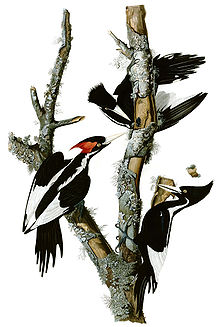Long-crested woodpeckers
| Long-crested woodpeckers | ||||||||||
|---|---|---|---|---|---|---|---|---|---|---|

Female of the Magellan Woodpecker ( Campephilus magellanicus ) |
||||||||||
| Systematics | ||||||||||
|
||||||||||
| Scientific name | ||||||||||
| Campephilus | ||||||||||
| Gray , 1840 |



The long- crested woodpeckers ( Campephilus ) are a genus of the woodpeckers (Picidae), which is represented with eleven species in the New World . The scientific name Campephilus (from gr. Κάμπια kampia for caterpillar and φιλία philia for friendship, love) refers to the preference for larvae as food. Two species and one subspecies, the ivory woodpecker ( Campephilus principalis ), the Cuban ivory woodpecker ( Campephilus principalis bairdii ) and the emperor woodpecker ( Campephilus imperialis ), are considered to be possibly extinct today.
description
They are medium-sized to very large woodpeckers, reaching sizes from 28 to 60 cm. Of these, the emperor woodpecker ( Campephilus imperialis ) from Mexico with a body length of 56 to 60 cm is the largest woodpecker in the world. The long-crested woodpeckers have mainly black and white plumage. The head is often red, sometimes black or black and white. Some species have impressive red or black hoods. Your fourth toe (the hallux ) is long and functional. Most species are characterized by their ivory-colored beaks, hence the common name Ivory-bills (ivory bills ). However, there are two species that have dark beaks, the cinnamon woodpecker ( Campephilus pollens ) and the blood-bellied woodpecker ( Campephilus haematogaster ).
habitat
Their habitat includes primary mountain forests, dry and wet forests, cloud forests and forest edges. The ivory woodpecker preferred dense hardwood forests and often inaccessible cypress swamp forests. Originally he apparently also lived in pine forests with many dead trees. The emperor woodpecker lived in mixed mountain forests, which are dominated by oaks and pines, at altitudes of 1670 m to 3050 m.
Way of life
Most species of long-crested woodpecker do not drum in the typical way to claim their territory, but rather hammer with unmistakable double or triple blows on the tree trunks. The second beat follows the first so quickly that the impression of a single beat with an echo is created. Their diet consists of beetle larvae and pupae. The long-crested woodpeckers cling to tree trunks in a peculiar way. Their legs are pointed more sideways than other woodpeckers, giving the impression that they are "hugging" the tree. Because all toes are more or less pointed forward, the tarsus touches the surface of the tree trunk, a position that is prevented in other species of woodpecker by the position of the hallux, the general position of the feet under the body and the direction of the pulling forces. Many species lead a secret way of life. Hence, they are difficult to study.
Systematics
The genus Campephilus was established in 1840 by George Robert Gray , who classified the ivory woodpecker as a type species . For a long time it was assumed that the long-crested woodpeckers are closely related to the representatives of the genus Dryocopus due to their similarity . However, a phylogenetic study from 2006 showed that Campephilus is a sister taxon of Chrysocolaptes .
Simplified cladogram according to Benz et al., 2006:
|
|
|
||||||
|
|
|||||||
|
|||||||
|
|
The Cuba ivory woodpecker ( Campephilus principalis bairdii ) was described by John Cassin in 1863 as an independent species, but soon afterwards considered as a subspecies of the ivory woodpecker ( Campephilus principalis ). In 2006, Robert C. Fleischer and his colleagues demonstrated in a phylogenetic study that the Cuban ivory woodpecker had split off from the ivory woodpecker in the Middle Pleistocene and therefore support a species status.
The oldest known fossil Campephilus species is Campephilus dalquesti from the Upper Pliocene of Texas, which was described by Pierce Brodkorb in 1971 .
Species and their distribution
- Guayaquil woodpecker ( Campephilus gayaquilensis ), Colombia, Ecuador and Peru
- King woodpecker ( Campephilus guatemalensis ), Central America
-
Blood-bellied woodpecker ( Campephilus haematogaster ), Colombia, Ecuador and Peru
- Ribbed blood-bellied woodpecker ( Campephilus haematogaster splendens ), Panama, Colombia and Ecuador, sometimes viewed as a separate species.
- Emperor Woodpecker ( Campephilus imperialis ), Mexico (possibly extinct)
- White-Mantled Woodpecker ( Campephilus leucopogon ), South America
- Magellan woodpecker ( Campephilus magellanicus ) Argentina and Chile
- Black-throated Woodpecker ( Campephilus melanoleucos ), South America
- Cinnamon woodpecker ( Campephilus pollens ) Colombia, Ecuador, Venezuela and Peru
-
Ivory woodpecker ( Campephilus principalis ) southeastern USA (possibly extinct)
- Cuba ivory woodpecker (
literature
- Hans Winkler , David Christie, David Nurney: Woodpeckers. Pica Press, 1995, ISBN 1-873403-25-9 .
- Gerard Gorman: Woodpeckers of the World. The Complete Guide . Christopher Helm, 2014, ISBN 978-1-4081-4715-3 .
Web links
Individual evidence
- ↑ a b Brett W. Benz, Mark B. Robbins, A. Townsend Peterson : Evolutionary history of woodpeckers and allies (Aves: Picidae): Placing key taxa on the phylogenetic tree. In: Molecular Phylogenetics and Evolution. 40, 2006, pp. 389-399. doi: 10.1016 / j.ympev.2006.02.021
- ^ A b Robert C. Fleischer, Jeremy J. Kirchman , John P. Dumbacher, Louis Bevier, Carla Dove, Nancy C. Rotzel, Scott V. Edwards, Martjan Lammertink , Kathleen J. Miglia, William S. Moore: Mid-Pleistocene divergence of Cuban and North American ivory-billed woodpeckers . In: Biology Letters . tape 2 , no. 3 , 2006, p. 466–469 , doi : 10.1098 / rsbl.2006.0490 , PMID 17148432 , PMC 1686174 (free full text) - ( si.edu [PDF]).
- ↑ Pierce Brodkorb: The paleospecies of woodpeckers. In: Quarterly Journal of the Florida Academy of Sciences. 33, 1971, pp. 132-134.